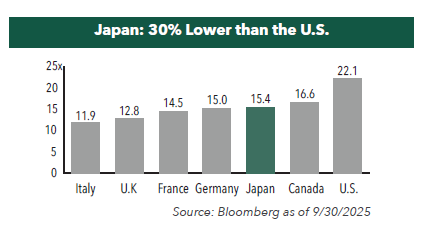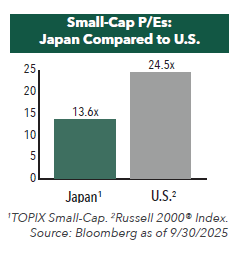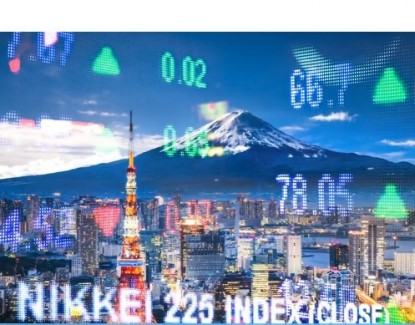Compelling Valuations in Japan
Japanese equities are currently trading at compelling valuation levels compared to other developed equity markets around the world and relative to their own historical averages. We believe the Japanese market deserves a closer look.
-
 Masakazu Takeda, CFA, CMAPortfolio Manager
Masakazu Takeda, CFA, CMAPortfolio Manager -
 Angus Lee, CFAPortfolio Manager
Angus Lee, CFAPortfolio Manager -
 Tadahiro Fujimura, CFA, CMAPortfolio Manager
Tadahiro Fujimura, CFA, CMAPortfolio Manager -
 Takenari Okumura, CMAPortfolio Manager
Takenari Okumura, CMAPortfolio Manager
1. Attractive Price-to-Earnings Multiple
The price-to-earnings multiple, or P/E ratio, is the most common measure used to value equities. Japanese large-cap equities, as represented by the Tokyo Price Index (TOPIX), are currently trading on a P/E multiple of 15.4x 2025 forward earnings, 30% lower than the U.S.

2. Low Price-to-Book
On a price-to-book basis (P/B), Japanese equities are also offering investors great value compared with other global developed equity markets. TOPIX is trading at just 1.6x book value, about a third lower than the average among the top developed equity markets and more than two-thirds lower than the U.S.

3. Japan Small-Caps at a Discount
Small-cap Japanese companies are also trading at a discount to international peers. Small-cap stocks in Japan are trading on just 13.6x 2025 forward earnings, and as a point of reference, a 44% discount to U.S. small caps trading at 24.5x.

4. Japan’s Attractive P/E Relative to History

Summary
We believe Japan’s growth story is just starting to unfold. Following the advent of Abenomics, many Japanese companies are experiencing higher profitability due to corporate restructuring, better governance, and a more competitive currency. With Japanese equities currently offering attractive valuations compared to G7 developed country equity markets and relative to history, we believe Japan deserves a closer look as a component of an investor’s portfolio.
- In this article:
- Japan
- Japan Fund
- Japan Small Cap Fund
You might also like
-
 Portfolio Perspective
Portfolio Perspective
Japan Small Cap FundA Focus on Japanese Small-Caps Making Big Corporate Improvements
 Takenari Okumura, CMAPortfolio Manager
Takenari Okumura, CMAPortfolio Manager Tadahiro Fujimura, CFA, CMAPortfolio ManagerRead the Commentary
Tadahiro Fujimura, CFA, CMAPortfolio ManagerRead the CommentaryThe Portfolio Managers discuss their view of the Japanese small-cap corporate landscape amid many shifting factors, including a new Prime Minister, finalized tariff situation, currency volatility, and attractive valuation environment.
-
 Portfolio Perspective
Portfolio Perspective
Japan FundCompelling Japanese Opportunities Amid Attractive Valuations
 Masakazu Takeda, CFA, CMAPortfolio Manager
Masakazu Takeda, CFA, CMAPortfolio Manager Angus Lee, CFAPortfolio ManagerRead the Commentary
Angus Lee, CFAPortfolio ManagerRead the CommentaryThe Hennessy Japan Fund Portfolio Managers highlight the effect of the new Prime Minister on the economy and market and how holdings were affected by the final trade agreement. They also discuss currency volatility, valuations, and the most compelling opportunities as we end 2025.
-
 Investment Idea
Investment IdeaWhy Active Matters When Investing in Japan
 Masakazu Takeda, CFA, CMAPortfolio Manager
Masakazu Takeda, CFA, CMAPortfolio Manager Angus Lee, CFAPortfolio Manager
Angus Lee, CFAPortfolio Manager Tadahiro Fujimura, CFA, CMAPortfolio Manager
Tadahiro Fujimura, CFA, CMAPortfolio Manager Takenari Okumura, CMAPortfolio ManagerRead the Investment Idea
Takenari Okumura, CMAPortfolio ManagerRead the Investment IdeaWhen investing in Japanese businesses, we believe it is imperative to select a manager who is immersed in the culture and can perform in-depth, company-specific research to build a concentrated portfolio of Japanese companies that can outperform a benchmark and weather volatility.
